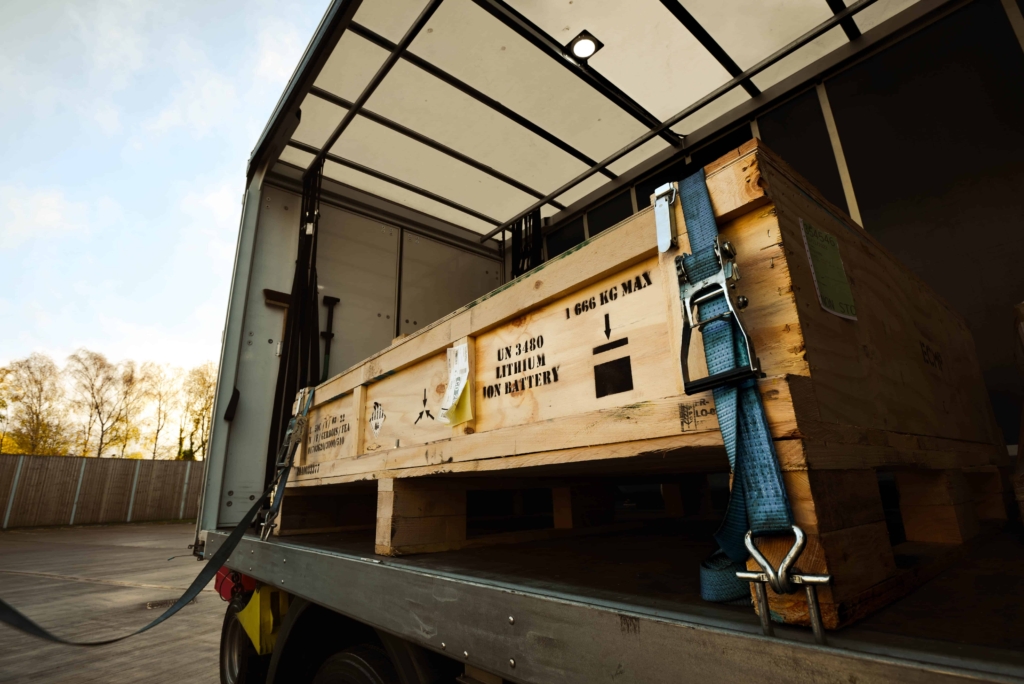Lithium batteries are now being used at an incredible rate due to their light weight, performance and relative low cost. The only downside are the dangers that come with transporting batteries such as, lithium Ion (rechargeable) and Lithium Metal (non-rechargeable). There have been well publicised accidents that involved Lithium batteries.
In September 2010, A United Parcel Service 747 cargo plane carrying more than 80,000 lithium metal and lithium-ion batteries from Hong Kong caught fire and crashed near Dubai in the United Arab Emirates. The plane’s two pilots, who were killed, reported smoke in the cockpit so thick they couldn’t see their instruments. The plane crashed into an empty dining hall that only a short while earlier had been full of people. Most fires that occur from lithium batteries are due to thermal runaway. A thermal runaway happens when conditions are met that cause reactions to occur and cannot be easily stopped. These reactions are exothermic, meaning that they give off heat, and that heat may be enough to cause a fire.
In September 2018, a fire occurred in the garage of the superyacht My Kanga, at that time at anchor in the coastal area of Croatia. The fire quickly developed to the upper decks resulting in an uncontrollable situation. It took less than 25 minutes for the fire to spread to the sun deck, accompanied by explosions. Orders were given to abandon the ship. The safety investigation that was published in 2019 concluded that the fire in all probability was caused by the lithium batteries of an electric surfboard. The crew was not aware of the fact how dangerous lithium batteries can be.
Where can I find lithium batteries?
Rechargeable lithium batteries are used in most of the electronic devices that you use daily. These include:
- Bluetooth Headsets
- Mobile Phones
- Computer Peripherals
- Digital Cameras
- E-Readers
- Game Controllers
- Laptops
- Smartwatch
- Smoke/Fire/Carbon Monoxide Detectors
- Tablets
Are lithium batteries classed as ADR/hazardous?
Yes. Lithium batteries, when transported, must follow the relevant legislation for the mode of transport: for road — the Agreement Concerning the International Carriage of Dangerous Goods by Road (ADR). There may be some exemptions depending on the lithium content of the battery.
Do I need special training or qualifications to ship lithium batteries?
Yes, or at least work with someone who is trained and understands all of the necessary regulations.
How can I safely pack lithium batteries for transportation?
Lithium batteries are high risk and very dangerous so must be packed very carefully and correctly. The major risk associated with them is a short-circuit because of the terminals encountering other batteries, metal objects or conductive surfaces.
- Packaged batteries or cells must be separated specifically to prevent short circuits and damage.
- Must be contained in a strong outer packaging unless it’s contained in equipment as it surrounds the battery and provides it with protection.
- For batteries contained in equipment, the packaging must provide protection against accidental operation during transportation.
Can I ship damaged / defective lithium batteries?
You are not allowed to ship faulty lithium batteries via couriers or post. Please speak with a qualified expert if you need to do this.
What are the rules for packing equipment with lithium batteries inside?
Effectively, when shipping any lithium batteries you should ensure you adhere to the Dangerous goods regulations. Whilst you can see further specific later in this guide, you should use good quality, sturdy packaging, ensure the devices / batteries cannot move or become “activated” during transit, ensure the appropriate labelling in in place (depending on how many items you are sending) and stick to the limits for numbers you can send in a single pack.
Definitions
What is IATA?
IATA is an acronym for the International Air Transport Association.
What is IMO?
IMO is an acronym for the International Maritime Organisation.
What is ADR?
ADR is short for The European Agreement Concerning the International Carriage of Dangerous Goods by Road.
What is UN3090?
UN 3090 comprises the United Nations regulations covering Lithium metal batteries (shipped by themselves).
What is UN3091?
UN 3091 comprises the United Nations regulations covering Lithium metal batteries contained in equipment or packed separately with a piece of equipment Battery packaging Battery packaging for Lithium Ion is tightly regulated by various legislation, including UN3480, UN3481 and IATA specific rules.
What is UN3480?
UN 3480 comprises the United Nations regulations covering Lithium ion batteries (shipped by themselves).
What is UN3481?
UN 3481 comprises the United Nations regulations covering Lithium ion batteries contained in equipment or packed separately with a piece of equipment.
We're ready when you need us


